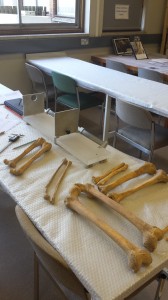I am a student at Reading I have now completed my second year of study. Over my summer I chose to undertake an Undergraduate Research Opportunities Programme (UROP) within the department of Archaeology. My area of research, which is an area of archaeology that I am very interested in is osteoarchaeology – the study of human skeletal remains from past societies.
Within our department there is a collection of the skeletons which were excavated from St Oswald’s Priory in Gloucester. This population is the focus of some of the research undertaken by my supervisor, Dr Mary Lewis whose specialism is in palaeopathology and the study of health, particularly in childhood in the past. The purpose of the research I have been undertaking is to find out whether limb atrophy, the wasting of a limb or a number of limbs (arms and legs) was prevalent within the Medieval and/or the Post Medieval population of this area of Gloucester. The Medieval population were living in the countryside and primarily agriculturalists compared with the Post Medieval industrial changes which would have had an impact on lifestyle and health. A very interesting part of placement is trying to discover what the cause of the odd length limbs might be: could it be natural asymmetry or handedness from differences in loading on limbs, or the pathological Poliovirus, Chickenpox or even poor midwifery practice and difficult causing this damage during childbirth including paralysis of the upper arm through Erb’s Palsy.
During the first week I set up the spreadsheet and collated some of the data which had already been collected. At this point I was introduced to the topic, and began getting into the palaeopathology literature to get an idea of what published journals related to this topic were all about. After this I got stuck into finding my way around the laboratory and navigating the store room where the skeletons are kept. I was then made familiar with the osteometric board and the digital calipers which I have been using for taking the relevant measurements including the total length of each long bone and the anterior-posterior (front to back) and medial-lateral (inside to outside). The placement so far has helped with cementing my knowledge of these techniques, also the siding of all of the long bones including those of adult and non-adults, and knowledge of what is involved in undertaking research and lab work both alongside a supervisor and independently.

In addition to the data collection I have been looking at some interesting pathologies that have been found within the population at St Oswalds such as those people that were infected with tuberculosis and syphilis long enough for the damage caused to be seen on the bones. There is also the occurrence of osteoarthritis, healed fractures and DISH (diffuse idiopathic skeletal hyperostosis) or Forestiers disease. Although interesting to study, the skeletons whose long bones have been severely affected by such trauma and pathologies cannot be used to take measurements for an underlying cause of limb atrophy because the obvious pathology is a clear cause of their odd shapes and appearances. What we are looking for in the population are the more subtle causes which may have been overlooked in other studies.


The next step in this research is some statistical analysis and then the interpretation of this data using excel and then taking a closer look at the skeletons which may be pathological, which I will soon be getting onto after reading further into the clinical literature to provide a background when discussing interpretations of the findings with my supervisor.

